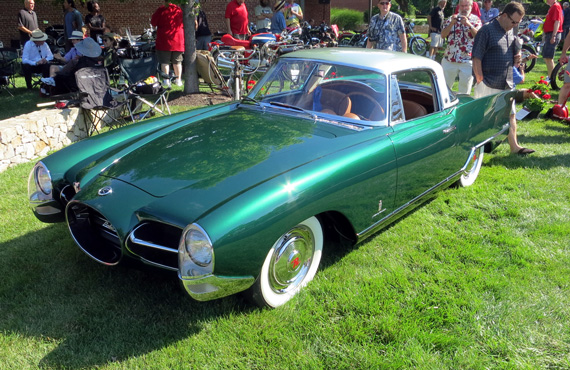
One of the concepts on the field that got a lot of attention was Scott Morris’ Rambler Palm Beach. This was a Pinin Farina creation built for American Motors Corporation. It was meant to be a replacement for Nash’s aging Nash-Healey and was first shown at the 1953 Turin Auto Show. The jet fighter-inspired design was a much more refined continuation of a theme Farina had begun with an open and closed version of the Lancia 200 earlier in 1953. Shortly thereafter, AMC cancelled both the Nash and Hudson nameplates so the car never reached production. It remained with AMC President, Roy Chapin for a while and is now with Mark Hyman. Both the colors and design are sublime and only the hubcaps reveal the chassis’ humble origins. The Rambler won Peterson Manufacturing’s Bright Ideas on the Move Award.
Story and Photos (unless otherwise noted) by Michael T. Lynch
The 2015 Edition of the Art of the Car Concours® presented by the Kansas City Mercedes-Benz Dealers broke all previous attendance records as well as having over 200 entrants on the campus of the Kansas City Art Institute. Most important was the fact that in the Art of the Car’s nine years of existence, it has now contributed well over $1 million to the Kansas City Art Institute Scholarship Fund. KCAI is a four-year, independent, fully accredited college of art and design offering the bachelor of fine arts degree in a variety of disciplines.
Attendance was up 20% from previous years and this was more than partially influenced by a branding and media plan put together by communications company Bernstein-Rein, who generously donated their time.
This year’s feature was concept/dream cars and there were 18 on the field including such gems as the Aerovette, the Pinin Farina X and the Rambler Palm Beach, another Pinin Farina masterpiece. Anchoring the concept cars was GM Futurliner #10, which has recently been added to the National Historic Vehicle Register of Historic Vehicles, which is administered by the Historic Vehicle Association and the Department of the Interior. The Futurliner had lines all day of people waiting to come aboard.
The format followed previous years, beginning with an entrants’ brunch held Saturday morning at Tivol, the city’s leading jeweler. The street in front of the shop was closed to give the public a preview of some of the cars, trucks and motorcycles that would be at the Concours the next day.
On Saturday afternoon a panel discussion of the history of dream/concept cars called Meet the Legends was held. At the dais were historian Michael T. Lynch; TV host Wayne Carini from Chasing Classic Cars, now in its 8th season on Velocity; Howard Sullivan, one of the crew of 46 who restored the Futurliner over six years; Tony Jones, the Interim President of the Kansas City Art Institute, and Ralph Marano, a Packard collector with the best selection of Packard concept cars extant. The conversation ranged from the early 1900s to the present with the emphasis on mid-Twentieth Century dream cars, considered to be the golden age of concept cars. Wayne Carini had some great stories about cars he was involved with that were pictured in the slide presentation. Howard did well describing the Futurliner’s importance in its era and Ralph Marano tutored on the finer points of Packard’s concept cars. Tony Jones was formerly Director of the Royal College of Art in London. It has one of the world’s leading vehicle design departments and Tony closed the proceedings with some fascinating comments of the future of automotive design.
Saturday evening saw a reception for exhibitors and the public on the KCAI campus. There was the usual catching up between people who had not seen each other since the previous year and the good fellowship flowed, as well as the wine.
On Sunday morning, Milan Johnson and his field crew began placing the cars. Because of the size of the Futurliner, extraordinary steps had to be taken to get it on the field including steel plates to make sure no sidewalks were collapsed. With that in place, the other vehicles streamed on the field.
TV personalities were out in force, and Concours Chairman Marshal Miller was being interviewed before the show even began by Fox’s Carey Wickersham. KSHB’s Joel Nichols and Crystle Lampitt shared announcing duties with Marshall Miller (Awards) and Michael T. Lynch (on field interviews and vehicle descriptions). The concept cars drew a great deal of attention and it was instructive that so many of the Ford and Chrysler products had Ghia bodywork. Near the Futurliner was a grouping of three GM sports cars including the Aerovette, a prototype rear-engine Corvette that never made production.
The Art of the Car Concours has neither judges nor classes. Trophies are donated by sponsors, the organizers and the Kansas City Art Institute. For a complete list of Award Winners,this year’s press reviews and other interesting information, please go to artofthecarconcours.com.
Below are some highlights of the day:

The oldest entry on the field was Cooper Weeks’ 1897 De Dion-Bouton. This one is from the first year of production. These were the first mass produced, internal combustion engine-driven vehicles. They were made for almost ten years with 15,000 produced. There were also numerous versions made with and without licensing agreements. One was driven 67 MPH in 1901. It won Best 100 year-old Vehicle.
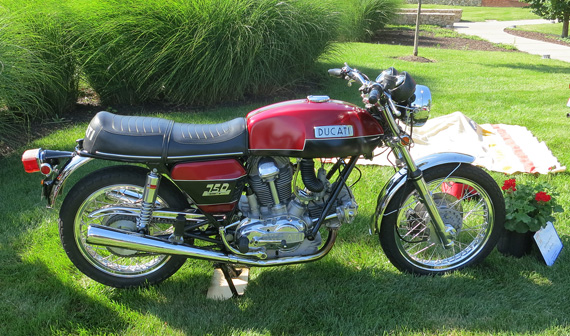
The Art of the Car always has a good selection of motorcycles, and this year there were 38. Jim van Eman bought this Ducati 750 GT new and raced it for two years. For a time, he rode it in the New Mexico desert. It has undergone a two year restoration and won the Motorcycle Peer Award, chosen by the other entrants and sponsored by Bob Peters.

Ralph Marano’s Vignale-bodied Packard is a mystery. The body is on a 1939 Packard 120 chassis, named for the length of its wheelbase. Several questions arise. Was it sent to Italy as a bare chassis? If not, did it lose its body during the war? How did it find its way to Vignale? It is thought that the coachwork was done in 1948, which would make it one of the first cars Vignale did under his own name. Whatever happened, the car is very Vignale with wonderful details. Alfredo was already a master. Despite the size of the car, his fluidity of design is just as evident as on the smaller cars he usually worked on.
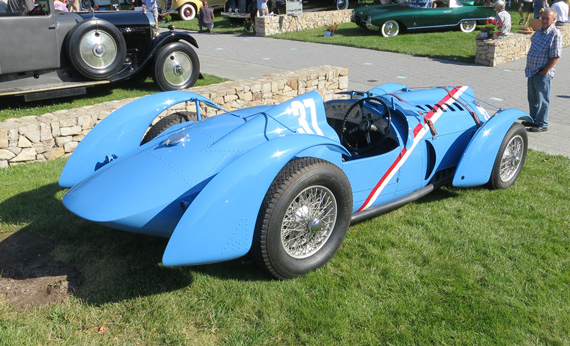
The Mullin Automotive Museum sent this Delahaye 145. Shown here in sports car guise, it is one of the most famous cars in French motor racing history. In 1937, it won a million franc prize meant to encourage French entries in Grand Prix racing, then dominated by the Germans. Because of that, it acquired the nickname, “Le Million”. It then defeated Caracciola’s Mercedes W154 at the Pau Grand Prix in 1938, one of the German team’s few losses in the era. It has an unusual V-12, with three camshafts in the block operating pushrod articulated valves. The car was originally financed by American heiress, Lucy O’Reilly Schell. The car won the Chairman’s Award. .
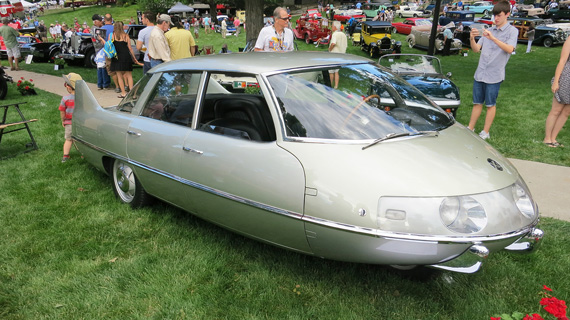
The Pinin Farina X was the designer’s concept of a sedan of the future in 1960 – notice the four doors. It has the requisite jet plane references in the fins and fuselage-like body. Some of what Pinin Farina predicted came true. The X obviously has a Coefficient of Drag (.23) that is equaled by few modern cars. The rhomboid wheel placement never became an industry standard. The single front wheel is for steering and the single rear wheel puts down the power of the Fiat 1100 engine. The two outriggers provide stability. Mark Hyman was the exhibitor.
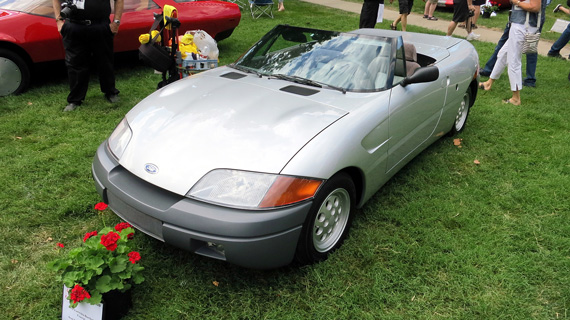
When Bob Lutz was a product guy at Ford, the company had Ghia create this snappy two-seater based on a European Ford Fiesta chassis. Try as he might, Lutz could not get the car approved for production. It would be five years before Mazda introduced a bare-bones sports car to the market, and we know how that worked out. Lutz said his failure was because all the market research was done in supermarket parking lots and the mostly female audience surveyed worried about practicality. Well-known Mercedes 300 SL restoration specialist, Scott Grundfor, also collects concept cars and this is one of four he sent to the Art of the Car Concours.
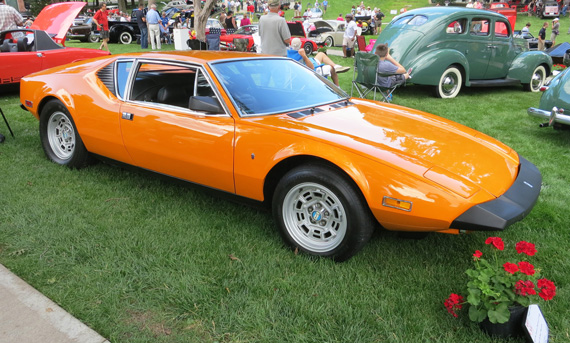
The De Tomaso Pantera was one of many attempts to combine the reliability of an American engine and the styling of an Italian supercar. Lincoln Mercury dealers sold these in the early 1970s and this is from 1974, the last year of Ford importation. Featuring a Ford V-8 and a ZF gearbox from the Ford GT40 racing car, the performance was spectacular. The L stands for Lusso, luxury in Italian, and this model was a much more civilized version than previous Panteras. This car was first purchased from Crown Lincoln Mercury at 3440 Main Street, Kansas City on January 6, 1975. Roger Morrison is only the second owner. The car had not previously been shown and is a true time capsule. It won the Spirit of the Hobby Award sponsored by Mark Hyman.
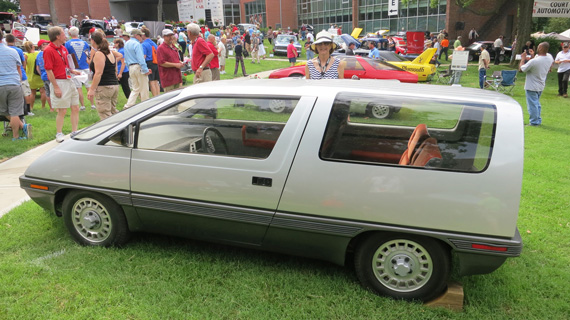
In the early 1980s, Ford was trying to develop a roomier vehicle compared to the traditional station wagon. Existing utility vans would not fit in all garages. This Minimax was done by Ghia for Ford but did not have the carrying capacity necessary. Ford also created a concept called the Carrousel at the other end of the size scale, but Henry Ford II demurred on both projects. When Ford fired Lee Iacocca, he was hired as President of Chrysler and brought Ford Director of Product Planning, Hal Sperlich with him. When Iacocca arrived, Chrysler was also trying to create a vehicle for this space. What Chrysler had on the boards was still too large and the Minimax was too small (two doors, no luggage space), so Iacocca and Sperlich suggested something between the Minimax and the concept Chrysler was working with. The result was the Plymouth Voyager, built on the K-car front-wheel drive platform. As with the Barchetta, Ford again had missed a market segment and Chrysler dominated the Minivan market for years. The Minimax is owned by Scott Grundfor, who was kind enough to bring three other Ford Ghia concepts.
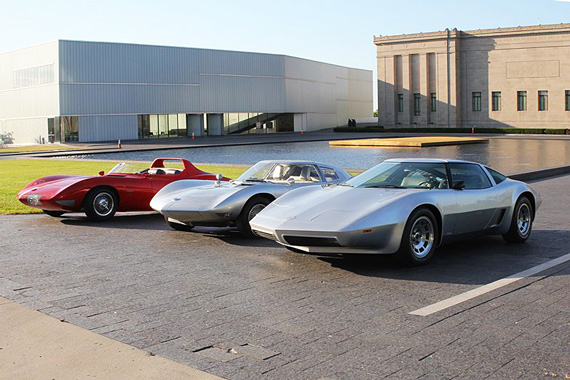
These three concept cars were brought by the GM Heritage Center. Here they pose in front of the new and old wings of the Nelson-Atkins Museum of Art. The two on the left are Corvair-based and designed by Larry Shinoda under GM Design Chief, Bill Mitchell and were first shown in 1963. GM was experimenting and the Monza SS (left) had its engine behind the rear axle like a standard Corvair. The Monza GT (center) placed it in front of the rear axle for better handling. These never made production, partially because of Ralph Nader’s book, Unsafe at Any Speed, which claimed that Corvairs were unstable.
The third car is very important in Corvette history. Named the Aerovette, it is the third in a series of concepts that began with similar styling and two Wankel engines running on a single crankshaft. By 1976, the styling had changed slightly and a 400 cubic inch Corvette engine had been inserted behind the driver. The car was actually approved for production in 1980 but the car’s three champions at GM, President Ed Cole, Chief Corvette Engineer Zora Arkus-Duntov and Design Chief, Bill Mitchell, all retired at about the same time. The new Corvette Chief Engineer, Dave McClellan, decided that the Corvette engine should remain in front. Nonetheless, one car magazine or another has reported monthly ever since about a coming rear-engine Corvette. Styling cues from the three cars influenced several GM products, especially the C3 Corvette. Credit: Bob Dinkins
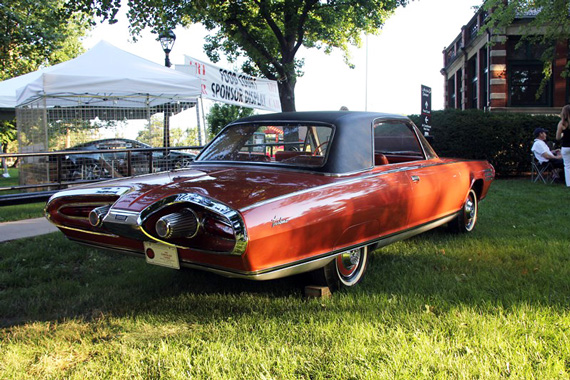
The St. Louis Museum of Transportation, which has a fabulous collection of locomotives as well as cars, shared their Chrysler Turbine with the Art of the Car Concours guests and exhibitors. Chrysler made 55, all bodied in the same style by Ghia. These were lent to families for evaluation. They also traveled around the world to bring attention to the new technology of a gas turbine-powered car. One amusing tidbit about their world travels was that when being demonstrated in Mexico City, President Adolfo López Mateos asked if the car could run on Tequila. The accompanying engineers complied and the car ran fine. Then in France, no less than Charles de Gaulle inquired about running the car on Chanel Number 5. Once again, the turbine was up to the task. One has to admire these leaders for promoting their countries’ products. Of the 55, most were crushed and this is one of two running examples. The other is owned by Car Guy Jay Leno. Credit: Bob Dinkins
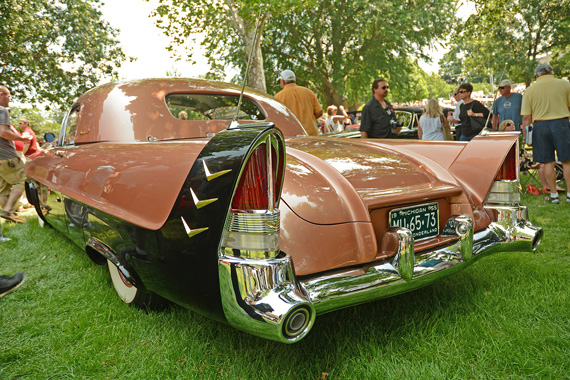
Ralph Marano’s 1954 Packard Panther concept won both the Curves Ahead Transportation Trophy for The Car with the Best Curves and the Hagerty Youth Judging Award. The car is a distinguished veteran of the 1950s fin wars in the industry.Credit: Brad Harding
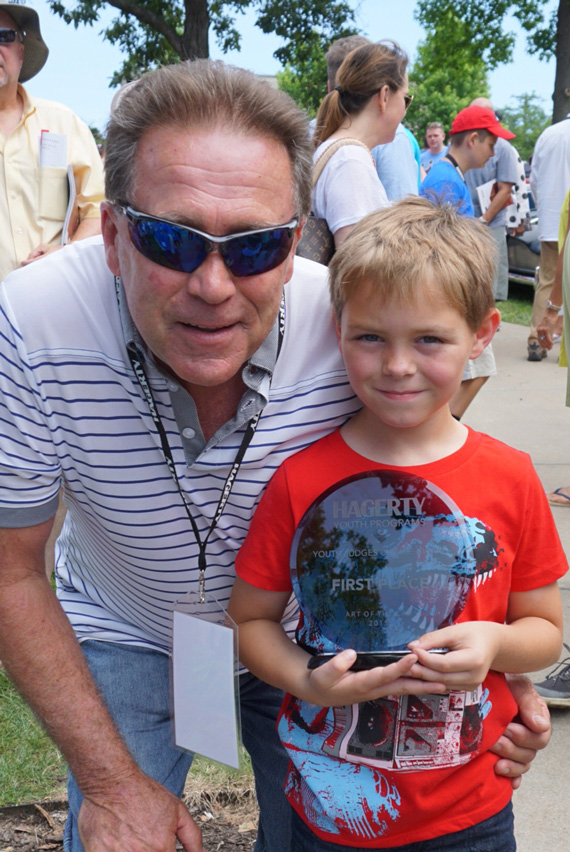
Hagerty Insurance runs a Youth Judging Program for young people between 8 and 14. The Judges are taken around the field and interact with car owners and other experts who explain why the cars are significant. With their new-found knowledge, they vote for cars to win Hagerty Awards. This builds a new generation of collectors and connoisseurs of exceptional automobiles. This year’s ‘Ahh Moment’ at the event occurred when Ralph Marano’s Packard Panther won both the Hagerty Youth Judging Trophy and the Curves Ahead Transport Award for The Car with the Best Curves. Rather than haul another award home where there are plenty of them, Ralph (left) generously gave the Hagerty Trophy to one of the Youth Judges, Caden Wilcox. Caden’s already in the spirit of modern motorsport, making sure his sponsor is exposed to the camera. Credit: Gary Krings
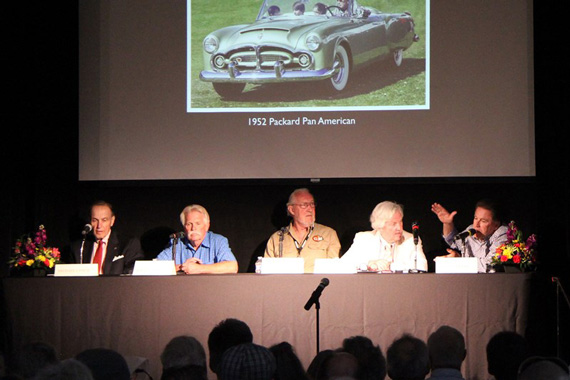
This year’s Meet the Legends Program was a discussion of the history of concept/dream cars. Participants from left are; Michael T. Lynch, Moderator, Wayne Carini of the Chasing Classic Cars TV show, Howard Sullivan, one of the team that restored the Futurliner, Tony Jones, Acting President of the Kansas City Art Institute, and Ralph Marano, noted collector, specializing in Packards. Here, Ralph Marano talks about his multi-award winning Packard Pan American. Credit: Bob Dinkins
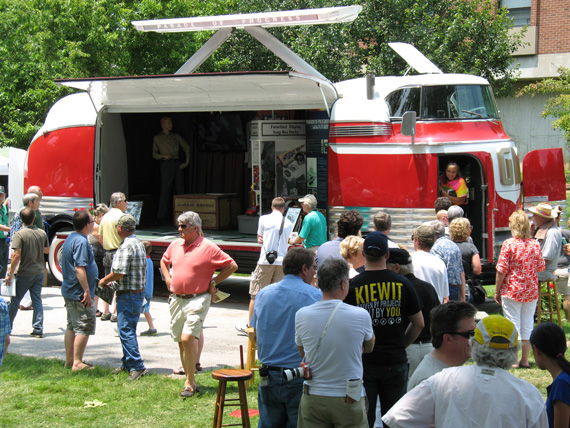
It wasn’t Italian or French, but the Futurliner was certainly the largest vehicle at the show. Howard Sullivan and his crew did a great job of answering people’s questions and explaining the bus’s importance in automotive history. There were lines all day as evidenced here to make the one-and-a-half story climb up to the driver’s position. A dozen of these busses traveled around the country, bringing the concepts of modern technology to the masses. They would set up at football fields, county fairs or anywhere they could draw a crowd. Concept cars often accompanied them. The upper structure is a light bar that allowed the dozen Futurliners to do a night show at venues without lighting. Each bus had a display of various aspects of 1950s technology. Credit: Ken Chester Jr.
Very interesting and fascinating group of cars. I like the concept of no judging unless there is going to be serious class judging for originality and authenticity. Such is clearly not the objective of the show and I applaud them for not having class awards. Too many judged concours events are too subjective and rely on judges who do not have sufficient knowledge. This can and does lead to awards that detract from an accurate history of the automobile. Congratulations to the Art of the Car Concours for a great show that recognizes the hazards of subjective class judging.
Regarding the Ford Carrousel and Chrysler minivans, back in I 1976 I was attending The Art Center College of Design as a Transportation Design major. Strother MacMinn was one of my instructors that year, and during that summer, our assignment from him was to design a garageable minivan. We were split into three groups; one to design the power train package, which we already knew would be front drive, another group was in charge of the cargo area, and the last group to design the exterior, which I was part of. Several weeks into the project we had the start of a full-size package drawings, a full-size mock-up fabricated of plywood and foam core, and some styling ideas. One member of the cargo group was a motorcycle enthusiast, so with the help from the other members of the group, they came up with a cargo area that would allowing a scrambler motorcycle to fit completely within the van. I also remember some Chrysler execs visiting the school, and seeing our mock-up, drawings, etc. and taking a keen interest in the project. At the time, there were also several full-size rendering of cars up on the wall, all of which had photographs of prototype alloy wheels that were designed at GM and were brought to the school by the son of one of the designers. One wheel design that really interested the execs was a wheel with drilled holes all throughout the surface. It later turned up on the Chrysler Laser and Dodge Daytona.
Hi Pete,
Please correct the spelling of former Corvette Chief Engineer Dave McLellan (remove trailing “d”).
Here’s Dave’s website, with some fun podcast interviews, http://corvettechief.com/
Another great story & photos, thanks!
— Doug Milliken
Good to hear from you! Thanks and the name is corrected.
Ed.
Wasn’t the Nash by PF found by Joe Bortz, the famous dream car barn finder? Love to hear what he paid for it. It’s interesting to see what dream cars execs took with them when they retired–that practicc seems to have ended with the ‘Fifties